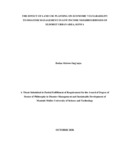THE EFFECT OF LAND USE PLANNING ONECONOMIC VULNARABILITY TO DISASTERMANAGEMENTINLOW INCOME NEIGHBOURHOODS OFELDORET URBAN AREA, KENYA
Abstract
The urban residents of low income neighbourhoods Worldwide faces economic vulnerability to Disaster due to difficulties to acquire serviced land to enhancetheireconomic resilience by improved human settlements and for commercial purposes.Land use planning seeks to regulate land use inordly and efficientmanner.Thus, it enableslow incomeurbanresidentsin neighbourhoods toaccess serviced land at affordable prices, access socio-economic services, infrastructure, transportation facilities and good environment. Thisstudy sought to evaluate the effect of land useplanning on economic vulnability to disastermanagement(EVDM), witha view to determine the best urban land use planning strategies and policies that could minimizedisaster riskamong the urban residentsin Eldoret Urban Area(EUA). Specifically the study went out:(i) To examine the influence of urban land useplanningregulatory instruments on economic vulnerability todisastermanagement inlow income neighbourhoods inEUA; (ii) To determine the effect of urban land zoning on economic vulnerability to disastermanagement inlow income neighbourhoods ofEUA;and (iii)To establish the effects ofurban land transitcirculation and connectivity on economic vulnerability to disastermanagement inlow income neighbourhoods ofEUA. Subsequently, H01, H02, and H03 were derivedfrom the specific objectivesrespectively. Descriptivesurveyresearch designwasused. The classical spatial economic theory (making room model);and disasterreduction theory (community-based model)wasappliedin this study.The study targetedthe urban residentsin Eldoret Urban Areasof(Langas,Kamukunji and Kapsaos). Proportional stratified random sampling wasapplied for the purpose of quantitative datacollection, while purposive sampling was used for qualitative data.A total sample size of 550 respondents wassampled.Questionnaire was the main instruments to collect primary data,alongside key informantinterviews (KIIs)and focus group discussions (FGDs).Finally; descriptive,inferential, regression and correlationstatistics wereapplied in data analysis and interpretation. Resultsindicated that land use planning regulatory instruments have combined influence of 69.0% over disastermanagement. Test results on H01 showed that there was significantly positive relationship between urban land use planning and disastermanagement. The effect of Land use planning regulatory instrument on EVDM was significant positive (R=0.878), the study revealedthat Land use planningregulatory instrument accounted for87.8% (R2=.771) of EVDM. The other variables in the urban areas explained the remaining 12.2%. Urban Land use Zoning (LUZ) had a combined influencedof 73.0% on EVDM.Test results on H02 indicatedthat there was a significant positive relationship between LUZ and EVDM activity level. Circulation and connectivity had a combined influence of 73.0% on EVDM. Test results for H03observed thatthere was a significant positive relationship between connectivity and circulation and EVDMactivitylevel (r= .883). Therewas an indication that Connectivity and Circulation explained 78.0% (R2=.780) of EVDM. Thefindings are a pointer to the factthat land use planning and its threedimensions had significantly positive effects oneconomic vulnerability to disastermanagement. From these results, itcanbeconcluded that urban land use planning is a critical tool or technique in designing and developing urban areas where hazardous zones are mapped, demarcated and kept off from urban residents’socioeconomic activities. The study recommendsthat urban authorities must focus on urban land use planning to achieve sustainable development and growth.

